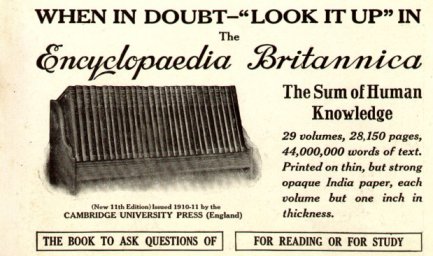Encyclopædia Britannica Eleventh Edition: Difference between revisions
mNo edit summary |
Maximus Rex (talk | contribs) m Reverted edits by Lord Rishartha to last version by MikeX |
||
| Line 1: | Line 1: | ||
{{msg:vfd}} {{msg:disambig}} {{msg:stub}} Thanks for experimenting with Wikipedia. Your test worked, and has now been removed. Please use [[Wikipedia:Sandbox]] for any other tests you want to do, since testing material in articles will normally be removed quickly. Please see the [[Wikipedia:Welcome, newcomers|welcome page]] if you would like to learn more about contributing to our encyclopedia. Thanks. {{msg:Disputed}} ''This article incorporates text from the public domain [[1911 Encyclopædia Britannica]]. ''The neutrality of this article is [[Wikipedia:NPOV dispute|disputed]].'' |
|||
The '''Eleventh Edition of the ''Encyclopædia Britannica''''' ([[1911]]) represents in many ways the sum of knowledge at the beginning of the [[20th century]]. The edition is still often regarded as the greatest edition of the [[Encyclopædia Britannica]], with many articles being up to 10 ''times'' the length of other encyclopædias. |
The '''Eleventh Edition of the ''Encyclopædia Britannica''''' ([[1911]]) represents in many ways the sum of knowledge at the beginning of the [[20th century]]. The edition is still often regarded as the greatest edition of the [[Encyclopædia Britannica]], with many articles being up to 10 ''times'' the length of other encyclopædias. |
||
Revision as of 04:58, 28 April 2004
The Eleventh Edition of the Encyclopædia Britannica (1911) represents in many ways the sum of knowledge at the beginning of the 20th century. The edition is still often regarded as the greatest edition of the Encyclopædia Britannica, with many articles being up to 10 times the length of other encyclopædias.
Some articles were written by the best-known scholars of the age, such as Edmund Gosse, J. B. Bury, Algernon Charles Swinburne, John Muir, Prince Peter Kropotkin, T.H. Huxley, and William Michael Rossetti, Henry Ford as well as many other names now less known. Many others were carried over from the Ninth Edition, some with minimal updating, some of the book-length articles divided into smaller parts for easier reference, yet others heavily abridged. Many articles are still of value and interest to modern readers and scholars. The best known authors generally contributed only a single article or part of an article, however. The majority of the work was done by a mix of journalists, British Museum staff, and academics. Among these lesser known contributors were some who would later achieve greatness such as Ernest Rutherford and Bertrand Russell.
The Eleventh Edition was a notable reorganization and rewriting of the Encyclopædia Britannica, which was first published in three volumes in 1768. The Eleventh Edition formed the basis for every edition of the Encyclopædia Britannica up until 1974, when the completely new Fifteenth Edition, based on modern information presentation, was published.
Sir Kenneth Clark, in Another Part of the Wood, wrote of the Eleventh Edition:
- One leaps from one subject to another, fascinated as much by the play of mind and the idiosyncrasies of their authors as by the facts and dates. It must be the last encyclopædia in the tradition of Diderot which assumes that information can be made memorable only when it is slightly coloured by prejudice. When T.S. Eliot wrote "Soul curled up on the window seat reading the Encyclopædia Britannica" he was certainly thinking of the eleventh edition.
The 1911 edition for the first time saw a number of female contributors. Thirty-four women contributed articles to the edition.
The 1911 edition is no longer restricted by copyright, and it is available in several more modern forms. The Project Gutenberg Encyclopedia volume 1 is actually 1911 EB volume 1, renamed to address Britannica's trademark concerns. However, Project Gutenberg currently only holds an electronic version of Volume 1.
Distributed Proofreaders is currently working on producing a complete electronic edition of the 1911 Encyclopædia Britannica, which will be available from Project Gutenberg when finished.
References
- All There is to Know (1994), edited by Alexander Coleman and Charles Simmons. Subtitled: "Readings from the Illustrious Eleventh Edition of the Encyclopædia Britannica". ISBN 0-671-76747-X
- Gillian Thomas. A Position to Command Respect: Women and the Eleventh Britannica New Jersey: The Scarecrow Press, 1992.
External links
Versions can be found at:
- 1911encyclopedia.org World Wide Web edition. This appears to be a raw, unproofread OCR-scanned version, and so contains many errors and no illustrations. However, it is free and text-searchable.
- ClassicEB.com for a CD-ROM version. This edition has all the illustrations, including thousands of steel engravings and line drawings, but is not text-searchable, since it consists of 300dpi images only. These pages also present a great deal of information about the Eleventh and other editions of the Encyclopædia Britannica.
The publishers of both versions above claim copyright on their versions (although the underlying text is public domain).
- www.robinsoncurriculum.com 1911 Encyclopaedia Britannica plus 250 books, most of K-12 curriculum for home schooling, 120,000 pages, for sale on 22 cdroms. Somebody check copyright claims? Unseen by this reviewer.

